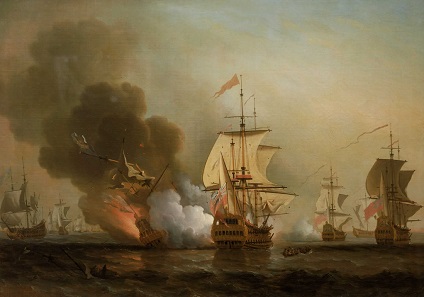by Annika Backe
December 8, 2016 – “One of the greatest discoveries (…) in the history of humanity” Colombian president, Juan Manuel Santos called the find of the galleon San José that was sunk more than 300 years ago off the coast of his country, on November 27, 2015. It is believed to be still loaded with an estimated $17 billion worth of gold coins and precious stones. According to international media, the salvage company Sea Search Armada (SSA) is now planning to actually recover this treasure – even if it means risking a war at sea.
The explosion of the San José. Oil painting by Samuel Scott (1702-1772).
The San José
The search for the San José shipwreck took decades. It had been the flagship of the Silver Fleet of King Philip V of Spain, serving to bring precious metal and other valuable goods from the colonies to the Spanish home. The galleon was sunk in a battle against the British Royal Navy, in an attempt to retrieve the precious cargo, on June 8, 1708 near Cartagena off the Colombian shore.
Protracted legal disputes
That was where the search was concentrating, conducted by a private company, a predecessor of SSA, since 1979. With the Colombian state, the company had entered a contract that, in the event of a successful outcome would render it entitled to a share of the find. The company’s announcement of the successful discovery in 1981 was not confirmed by state authorities. Following a complaint from SSA and years of dispute over ownership rights, a court decided in 2011 that the galleon belonged to the Colombian state. The news from November 27, 2015 with which Colombian officials enthusiastically announced that the wreckage had finally been found – at a different location where no one had searched before – was discarded by the SSA. The firm said the alleged discrepancy was due to a change in tracking technology.
Treasure as potential war trigger
The SSA believes to be entitled to finally start recovering the wreckage nicknamed “holy grail”. The Colombian government threatens with military actions in the case of any unauthorized activities in jurisdictional maritime areas. SSA points out that any fire on its U.S.-flagged vessel will be considered an act of war against the United States.
A voice of reason?
Almost forgotten in all of this is Spain to whose fleet the San José had belonged. There, however, nobody says anything of recovery. Although the Spanish Justice Minister promoted the idea to showcase parts of the treasure in a museum, he stressed that hundreds of his countrymen had lost their life when the ship was sunk. The best way to respect the cultural heritage it represents would be to just leave it where it is.
It seems doubtful whether the moderate Spanish view will prevail. The greed of those who want to get their hands on the riches at all costs is more likely to gain the upper hand at the end of the day.
You can watch a movie about the discovery of the San José on YouTube.
An overview of the facts related to the Silver Fleet is provided by Wikipedia.
A short film reporting about the Colombian find from November 2015 can be watched here.
About the find of another ship of the Silver Fleet you can read in CoinsWeekly.
And almost 175,000 shipwrecks are recorded in this database.




